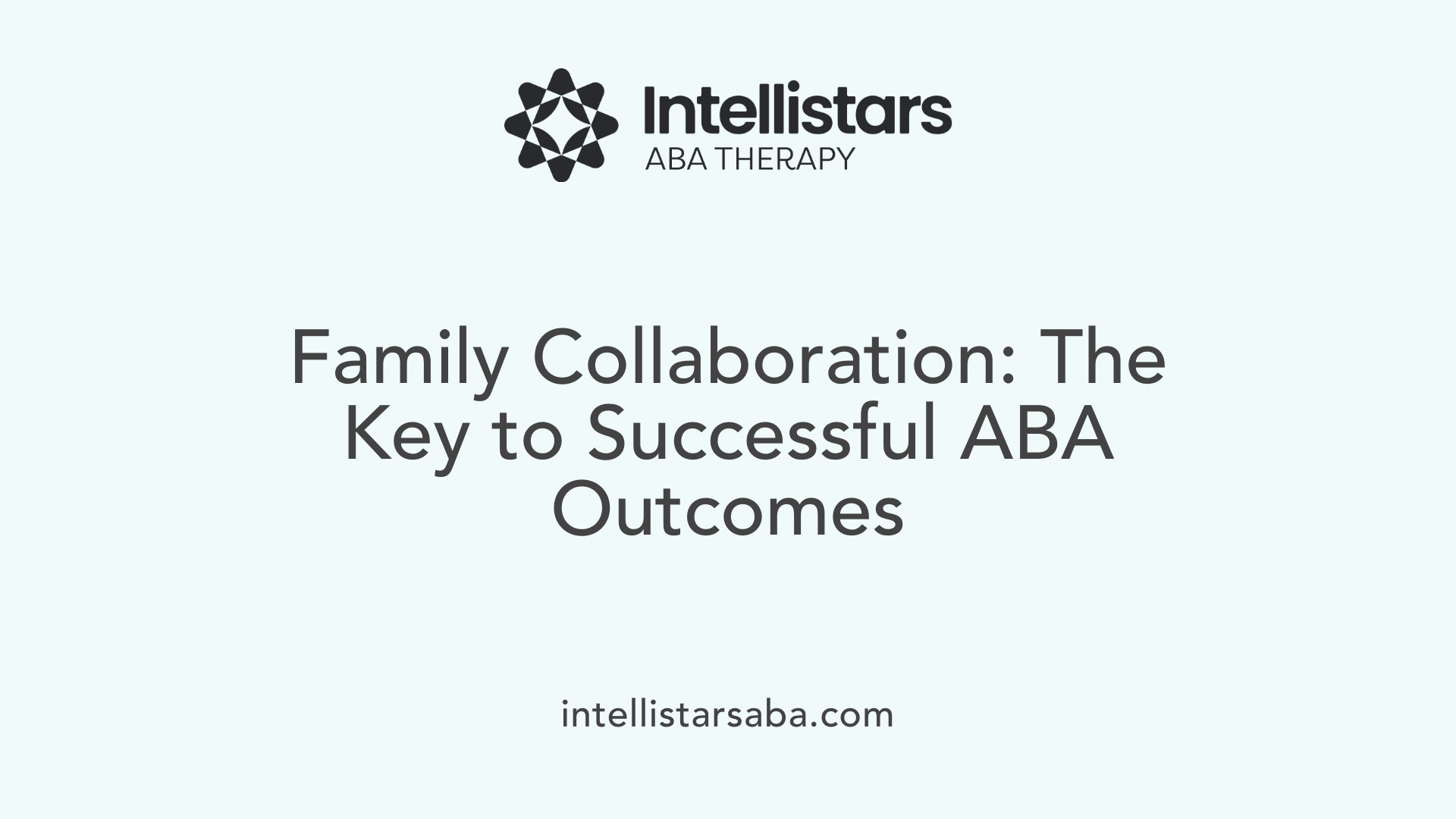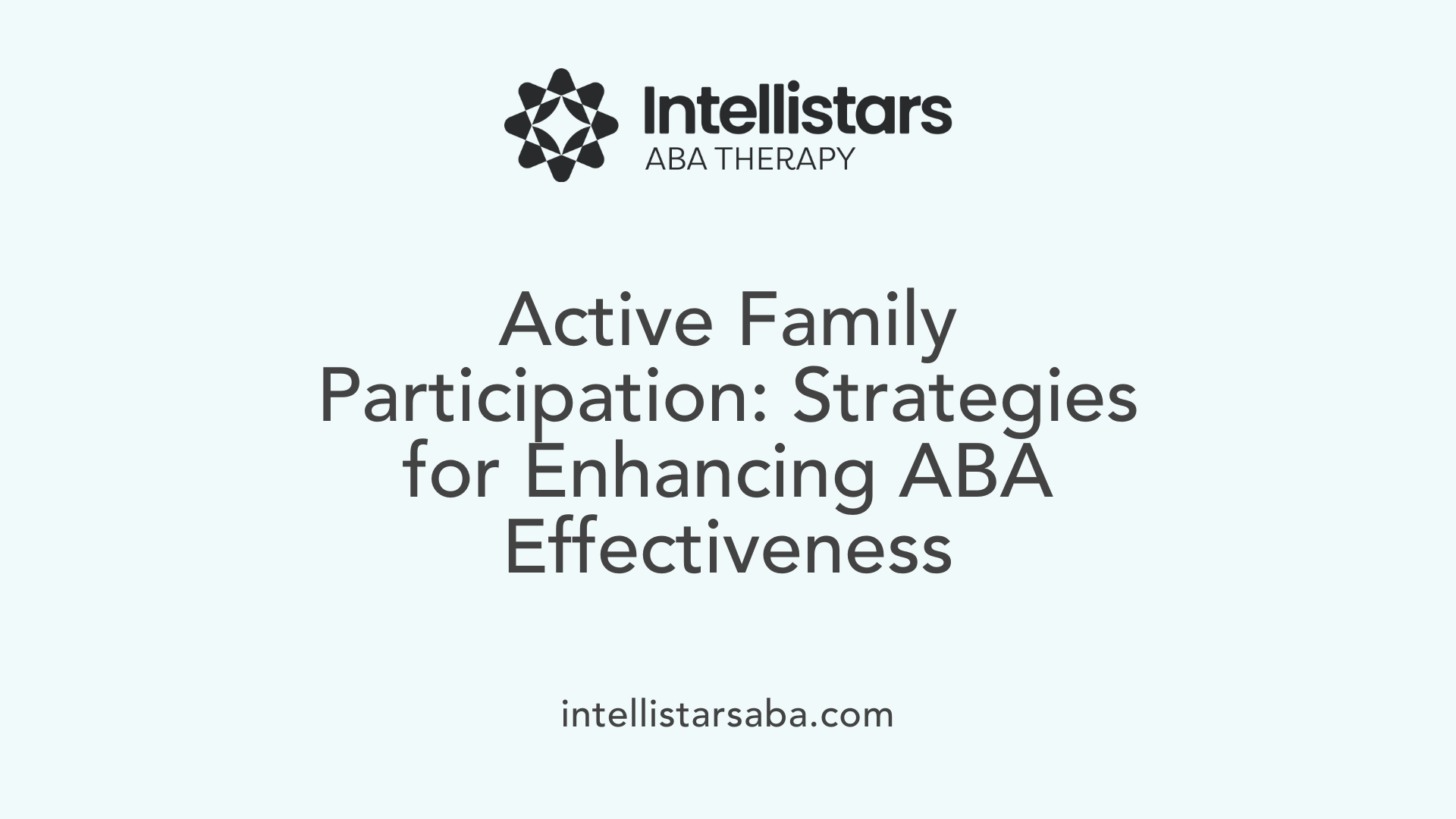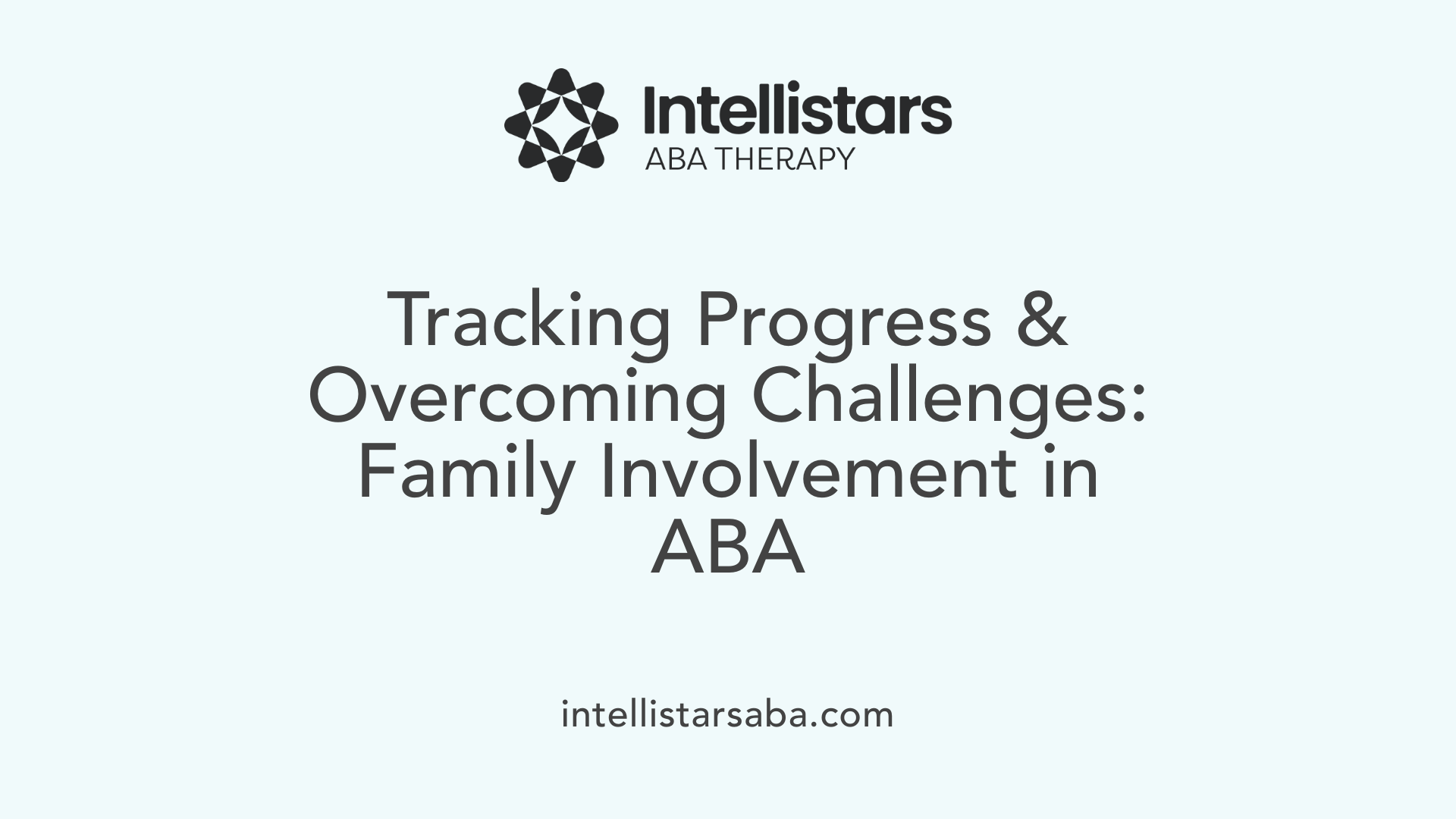Understanding the Importance of Family in ABA Therapy
Applied Behavior Analysis (ABA) therapy is a scientifically supported approach that helps individuals with autism acquire essential skills and reduce challenging behaviors. While this therapy is delivered by qualified professionals, the involvement of family members, especially parents and caregivers, is fundamental to maximizing its success. This article explores the critical role family collaboration plays in ABA therapy outcomes, highlighting strategies for engagement and the benefits of a united approach.
What is ABA Therapy and Who Provides It?

What is Applied Behavior Analysis (ABA) therapy and how does it support individuals with autism?
Applied Behavior Analysis (ABA) therapy is a scientifically supported method focused on understanding and modifying behavior through learning principles and reinforcement. It aims to promote helpful behaviors such as improved communication, social interactions, and daily living abilities, while reducing challenging behaviors. ABA breaks down complex skills into small, teachable steps and uses positive reinforcement to encourage progress.
Each ABA program is carefully tailored to the individual's needs, developed by trained behavior analysts who work closely with families. Techniques include prompting, repetitive practice through discrete trials, and applying skills in natural settings. Supported by extensive research and recognized by organizations like the American Psychological Association, ABA therapy has demonstrated effectiveness for individuals with autism of all ages, especially when started early and delivered intensely. The ultimate goal is to enhance independence and quality of life by teaching practical, everyday skills.
Who provides ABA therapy and what qualifications do these professionals typically have?
ABA therapy is delivered by licensed professionals such as Board-Certified Behavior Analysts (BCBAs), Registered Behavior Technicians (RBTs), and certified ABA therapists. These experts have specialized training in behavioral science and autism interventions and maintain certifications through ongoing education to stay current with best practices.
Collaboration with families is essential in successful ABA programs. Professionals often provide parent training and involve caregivers in reinforcing skills at home and in daily life. Through assessments like Functional Behavior Assessments (FBA), providers customize interventions that use evidence-based methods like reinforcement and discrete trials.
Together, qualified ABA providers and family members work to create individualized, data-driven programs aimed at improving communication, social abilities, and reducing problematic behaviors. This team approach ensures consistency across environments, accelerating the child's progress and fostering lasting benefits.
Central Role of Family Collaboration in ABA Therapy Success

Why is family involvement important in ABA therapy?
Family involvement is essential in ABA therapy as it ensures consistency and helps generalize skills across different environments. When parents and caregivers actively participate, they reinforce therapy techniques beyond sessions, fostering lasting progress for children with autism spectrum disorder (ASD).
How does family participation promote consistency and generalization?
Active family participation supports the application of learned skills in the home, community, and daily routines. This consistency across settings accelerates progress and improves communication by creating a stable, supportive environment where children can practice and strengthen behaviours learned during therapy.
What roles do parents and caregivers play in ABA therapy?
Parents and caregivers engage in multiple roles including:
- Participating in parent training programs to acquire techniques.
- Guiding therapy sessions at home.
- Collaborating in goal setting tailored to the child’s needs.
- Reinforcing skills and managing challenges with strategies learned through training.
This involvement empowers families and reinforces a supportive dynamic essential for therapeutic success.
What collaboration strategies enhance therapist-family partnerships?
Effective collaboration depends on open communication and mutual involvement. Key strategies include:
- Regular meetings to discuss progress and adjust goals.
- Parent training workshops and resources to deepen understanding.
- Transparent sharing of feedback and experiences.
- Tailoring support to each child's unique needs.
Therapists act as guides and resources, ensuring families feel supported and connected throughout the treatment process. This partnership fosters a sense of ownership and resilience that benefits the child’s development.
| Aspect | Description | Impact on ABA Therapy Outcomes |
|---|---|---|
| Family Involvement | Active participation in therapy and daily reinforcement | Enhances skill generalization and accelerates progress |
| Consistency Across Environments | Applying ABA strategies at home, school, and community | Promotes stable learning and behavior support |
| Parental Roles | Training, goal setting, home-based reinforcement | Empowers families and ensures continuity |
| Collaboration Strategies | Open communication, regular updates, individualized support | Builds partnership and improves therapy effectiveness |
How Families Can Actively Participate in ABA Therapy

Parent Training Programs
Parent training is a cornerstone of effective ABA therapy. These programs equip parents with the necessary skills to reinforce therapy techniques at home and in everyday situations. Training may include workshops or seminars where caregivers learn to manage challenges, support skill development, and apply behavioral strategies consistently across environments.
Caregiver-Guided Sessions and Home-Based Therapy
Families can engage directly in therapy through caregiver-guided sessions. Here, therapists work alongside parents to model techniques and provide hands-on guidance. Home-based therapy allows parents to apply learned strategies within the comfort of their own homes, enhancing the generalization of skills and ensuring consistent practice.
Collaborative Goal Setting
Successful ABA therapy involves setting clear, individualized goals collaboratively between therapists and families. Parents contribute valuable insights about their child’s needs, preferences, and daily routines. This partnership ensures that therapy targets are meaningful and achievable, fostering motivation and progress.
Maintaining Open Communication and Regular Meetings
Open lines of communication between therapists and families are essential. Scheduling regular meetings helps to discuss progress, make adjustments, and share observations. This ongoing dialogue builds trust and strengthens the support system around the child, ultimately promoting successful outcomes.
By engaging in these active roles, families create a supportive environment that accelerates progress, empowers parents, and maximizes the benefits of ABA therapy.
Measuring Progress and Overcoming Challenges Through Family Engagement

How is progress typically measured and tracked in ABA therapy programs?
Progress in ABA therapy is systematically tracked through meticulous data collection focused on targeted behaviors and skills. Therapists often use various methods such as frequency recording, duration measurement, interval recording, and ABC (Antecedent-Behavior-Consequence) data to capture detailed information during therapy sessions.
Families play an essential role in this data collection by observing and recording behaviors in natural settings like home or community, which helps generalize skills across environments. Maintaining behavior journals and using digital apps can simplify this process, making data more accurate and accessible.
Collected data is compiled into comprehensive progress reports, which include analysis of goal attainment, qualitative insights, and recommendations for next steps. These reports act as a bridge between therapists and families, promoting transparency, shared understanding, and collaborative decision-making about therapy adjustments.
Addressing challenges such as time commitment and emotional impact
Family involvement requires time and emotional energy, which can be challenging for caregivers managing multiple responsibilities. To ease this burden, therapists encourage open communication and offer tailored support such as parent training sessions and flexible meeting arrangements.
Educational workshops and resources empower families with practical skills, helping them feel more confident and less stressed. Recognizing caregivers' emotional impact, providers often create support networks and encourage self-care practices to sustain long-term engagement.
Empowerment and partnership benefits from family involvement
Active family participation fosters a strong partnership between therapists and caregivers, cultivating a sense of ownership over the therapy process. This empowerment strengthens motivation and consistency, directly influencing the child's progress.
Collaboration encourages families to take leadership roles in goal setting and implementation, aligning therapy outcomes with the child’s unique needs. Such involvement builds supportive environments across home, school, and community, making gains more durable and meaningful.
By integrating data collection, addressing challenges sensitively, and cultivating partnership, family engagement becomes a cornerstone of successful ABA therapy outcomes.
Debunking Myths and Building Resilience Through Family Education
What are common myths or misconceptions about ABA therapy for autism?
Many myths surrounding ABA therapy arise from misunderstandings about its methods and goals.
One widespread misconception is that ABA involves punishment or harsh techniques. Contrary to this belief, modern ABA therapy centers on positive reinforcement, ethically encouraging desired behaviors rather than using punitive methods.
Another myth is that ABA aims to "cure" autism. In fact, the therapy focuses on developing skills and enhancing the quality of life for individuals with autism, regardless of whether they are verbal or nonverbal.
Some people think ABA follows a rigid, inflexible program for everyone. However, ABA is highly individualized, customized to the unique needs and goals of each person to maximize effectiveness.
Ethical use of positive reinforcement
ABA therapy’s ethical foundation lies in its use of positive reinforcement techniques. This approach increases the likelihood of skill acquisition and desirable behaviors by rewarding progress and effort, creating a supportive and respectful environment.
Flexibility and individualization in ABA
ABA is not a one-size-fits-all program. Therapists collaborate closely with families to tailor goals and interventions. This flexibility ensures that therapy addresses each child’s strengths and challenges, maximizing meaningful outcomes.
Educational resources and workshops for families
ABA providers often offer educational resources, workshops, and seminars to families. These programs improve understanding of therapy principles, assist parents in applying techniques at home, and build resilience by fostering acceptance and support networks.
Through family education that dispels myths and provides practical tools, ABA therapy becomes a collaborative, empowering journey for children with autism and their families.
Empowering Families to Enhance ABA Therapy Outcomes
Family collaboration is a cornerstone of successful ABA therapy, fostering consistency, supporting skill generalization, and empowering parents and caregivers as active partners in intervention. By engaging in training, communication, and shared decision-making, families help create a supportive environment that extends beyond therapy sessions into everyday life. Addressing misconceptions and providing educational resources further strengthen this partnership, ensuring that ABA therapy fulfills its promise to improve the quality of life for individuals with autism. Ultimately, the combined efforts of therapists and families make ABA a truly effective, compassionate, and individualized approach to autism support.
References
- The Role of Family Involvement in ABA Therapy
- The Importance of Parental Involvement in ABA Therapy
- The Impact of Family Involvement in ABA Therapy
- Debunking 7 Common Myths About ABA Therapy - GSEP Blog
- 8 Common Myths About ABA Therapy Debunked
- 7 Myths About Applied Behavior Analysis
- Myths & Facts About Applied Behavior Analysis






